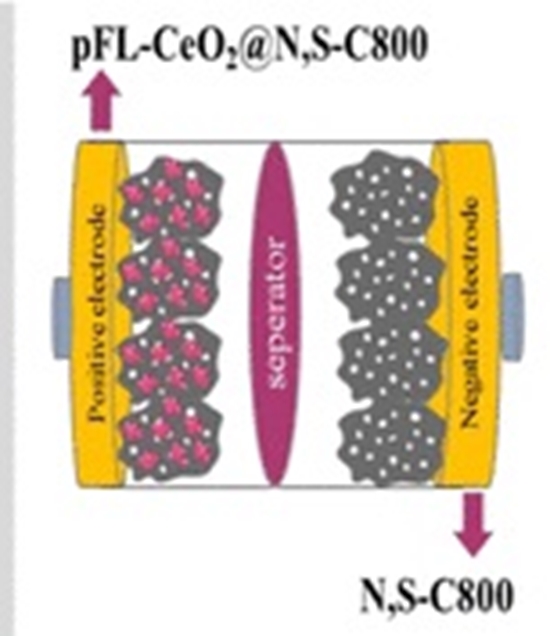High-Performance Hybrid Supercapacitor Based on Morphology-Controlled Cerium Oxide on N,S-Doped Porous Carbon
In this study, we developed composite materials based on porous carbon doped with nitrogen and sulfur heteroatoms and integrated with ceria, targeting applications in high-performance supercapacitors.

Abstract
In this study, we developed composite materials based on porous carbon doped with nitrogen and sulfur heteroatoms and integrated with ceria, targeting applications in high-performance supercapacitors. The synthesis was carried out using a simple and accessible method by which carbon materials containing sulfur and nitrogen were obtained by pyrolyzing a PTC-calix[4]resorcinarene porous organic polymer at various temperatures. Among the samples, porous carbon doped with nitrogen and sulfur at 800 °C (N,S-C800) exhibited a highly developed pore structure, which helped shorten the electron transport path. The presence of nitrogen and sulfur heteroatoms enhanced not only the electrical conductivity but also the material’s wettability, thereby facilitating electrolyte diffusion into internal pores. The N,S-C800 sample demonstrated an impressive specific capacitance of 407 F/g at 1 A/g and retained 87% of its capacitance after 1000 charge–discharge cycles. Furthermore, two distinct morphologies of cerium oxide were incorporated into the N,S-C800 matrix: spherical nanoparticles (NP-CeO2) and a porous flower-like structure (pFL-CeO2). Electrochemical performance evaluation revealed that the pFL-CeO2@N,S-C800 composite achieved a specific capacitance of 910 F/g at 1 A/g, while the NP-CeO2@N,S-C800 composite reached 750 F/g under the same conditions. The improved performance of the flower-like structure is ascribed to its efficient facilitation of electron and ion transport. Subsequently, a two-electrode system (pFL-CeO2@N,S-C800//N,S-C800) was assembled, employing pFL-CeO2@N,S-C800 and N,S-C800 as the positive and negative electrodes, respectively. This configuration exhibited a notable energy density of 31 Wh kg–1 at a power density of 750 W kg–1.




ارسال نظر